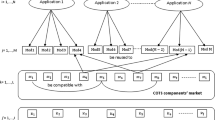Abstract
Component-based Software Engineering uses components to construct systems, being a means to increase productivity by promoting software reuse. This work deals with the Component Selection Problem in a multilevel system structure. A fuzzy-based approach is used to construct the required system starting from the set of requirements, using both functional and non-functional requirements. For each selection step, the fuzzy clustering approach groups similar components in order to select the best candidate component that provide the needed required interfaces. To evaluate our approach, we discuss a case study for building a Reservation System. We compare the fuzzy-based approach with an evolutionary-based approach using a metric that assess the overall architecture of the obtained systems, from the coupling and cohesion perspective.
Access this chapter
Tax calculation will be finalised at checkout
Purchases are for personal use only
Similar content being viewed by others
References
e Abreu, F.B., Goulao, M.: Coupling and cohesion as modularization drivers: are we being over-persuaded? In: Conference on Software Maintenance and Reengineering, pp. 47–57 (2001)
Becker, C., Rauber, A.: Improving component selection and monitoring with controlled experimentation and automated measurements. Inf. Softw. Technol. 52(6), 641–655 (2010)
Bezdek, J.: Pattern Recognition with Fuzzy Objective Function Algorithms. Plenum Press, New York (1981)
Cox, P., Song, B.: A formal model for component-based software. In: Symposium on Visual/Multimedia Approaches to Programming and Software Engineering, pp. 304–311 (2001)
Crnkovic, I.: Building Reliable Component-Based Software Systems. Artech House Inc., Norwood (2002)
Fenton, N.E.: Software Metrics: A Rigorous Approach. Chapman and Hall, London (1991)
Iribarne, L., Troya, J., Vallecillo, A.: Selecting software components with multiple interfaces. In: The EUROMICRO Conference Component-Based Software Engineering, pp. 26–32 (2002)
Kwong, C., Mu, L., Tang, J., Luo, X.: Optimization of software components selection for component-based software system development. Comput. Ind. Eng. 58(1), 618–624 (2010)
Bertrand, M.: Software Engineering. Addison-Wesley, Longman Publishing Co., Inc., Boston (2001)
Parsa, S., Bushehrian, O.: A framework to investigate and evaluate genetic clustering algorithms for automatic modularization of software systems. In: International Conference on Computational Science, pp. 699–702 (2004)
Seker, R., van der Merwe, A.J., Kotze, P., Tanik, M.M., Paul, R.: Assessment of coupling and cohesion for component based software by using Shannon languages. J. Integr. Des. Process Sci. 8, 33–43 (2004)
Vescan, A.: A metrics-based evolutionary approach for the component selection problem. In: The International Conference on Computer Modelling and Simulation, pp. 83–88 (2009)
Vescan, A., Grosan, C.: Evolutionary multiobjective approach for multilevel component composition. Studia Univ. Babes-Bolyai, Informatica LV(4), 18–32 (2010)
Vescan, A., Grosan, C., Yang, S.: A hybrid evolutionary multiobjective approach for the dynamic component selection problem. In: The International Conference on Hybrid Intelligent Systems, pp. 714–721 (2011)
Vescan, A., Serban, C.: Multilevel component selection optimisation and metrics-based architecture evaluation. Soft Comput. J. 0, 1–1 (2015, submitted)
Vescan, A., Serban, C.: Details on case study for the multilevel componentselection optimisation approach (2016). http://www.cs.ubbcluj.ro/~avescan/?q=node/95
Zadeh, L.: Fuzzy sets. Inf. Control 8, 338–353 (1965)
Author information
Authors and Affiliations
Corresponding author
Editor information
Editors and Affiliations
Rights and permissions
Copyright information
© 2016 Springer International Publishing Switzerland
About this paper
Cite this paper
Vescan, A., Şerban, C. (2016). A Fuzzy-Based Approach for the Multilevel Component Selection Problem. In: Martínez-Álvarez, F., Troncoso, A., Quintián, H., Corchado, E. (eds) Hybrid Artificial Intelligent Systems. HAIS 2016. Lecture Notes in Computer Science(), vol 9648. Springer, Cham. https://doi.org/10.1007/978-3-319-32034-2_39
Download citation
DOI: https://doi.org/10.1007/978-3-319-32034-2_39
Published:
Publisher Name: Springer, Cham
Print ISBN: 978-3-319-32033-5
Online ISBN: 978-3-319-32034-2
eBook Packages: Computer ScienceComputer Science (R0)




